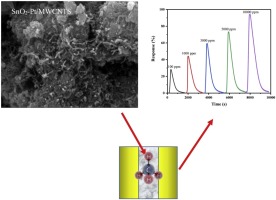当前位置:
X-MOL 学术
›
Synth. Met.
›
论文详情
Our official English website, www.x-mol.net, welcomes your feedback! (Note: you will need to create a separate account there.)
Design and evaluation of SnO2-Pt/MWCNTs hybrid system as room temperature-methane sensors
Synthetic Metals ( IF 4.4 ) Pub Date : 2020-02-01 , DOI: 10.1016/j.synthmet.2019.116267 S Navazani , M Hassanisadi , M.M Eskandari , Z Talaei
Synthetic Metals ( IF 4.4 ) Pub Date : 2020-02-01 , DOI: 10.1016/j.synthmet.2019.116267 S Navazani , M Hassanisadi , M.M Eskandari , Z Talaei

|
Abstract Herein, methane-sensing materials, including SnO2, Pt/MWCNTs, and SnO2-Pt/MWCNTs were synthesized and used to measure the sensing responses to 100−10000 ppm methane at room temperature. However, results showed presence of Pt and MWCNTs has significant effect on increasing the response of SnO2 sensors toward methane gas. Exposed to 100 ppm methane, SnO2, Pt/MWCNTs and SnO2-Pt/MWCNTs demonstrated 1 %, 19.95 % and 28.25 % sensing response at room temperature, respectively. Using Pt/MWCNTs, enhanced sensing features of the bare SnO2 and the obtained hybrid sensor indicated more stability at continuous working cycles. At a lower detected concentration of methane, time of response and recovery of SnO2-Pt/MWCNTs nanohybrid sensor were 176 s and 763 s, respectively. A methane sensing mechanism was also suggested based on the experiments.
中文翻译:

作为室温-甲烷传感器的 SnO2-Pt/MWCNTs 混合系统的设计和评估
摘要 本文合成了甲烷传感材料,包括 SnO2、Pt/MWCNTs 和 SnO2-Pt/MWCNTs,并用于测量室温下对 100-10000 ppm 甲烷的传感响应。然而,结果表明 Pt 和 MWCNT 的存在对增加 SnO2 传感器对甲烷气体的响应具有显着影响。暴露于 100 ppm 甲烷,SnO2、Pt/MWCNT 和 SnO2-Pt/MWCNT 在室温下分别表现出 1%、19.95% 和 28.25% 的传感响应。使用 Pt/MWCNTs,裸 SnO2 和获得的混合传感器的增强传感特性表明在连续工作循环中具有更高的稳定性。在较低的甲烷检测浓度下,SnO2-Pt/MWCNTs 纳米复合传感器的响应时间和恢复时间分别为 176 秒和 763 秒。还基于实验提出了甲烷传感机制。
更新日期:2020-02-01
中文翻译:

作为室温-甲烷传感器的 SnO2-Pt/MWCNTs 混合系统的设计和评估
摘要 本文合成了甲烷传感材料,包括 SnO2、Pt/MWCNTs 和 SnO2-Pt/MWCNTs,并用于测量室温下对 100-10000 ppm 甲烷的传感响应。然而,结果表明 Pt 和 MWCNT 的存在对增加 SnO2 传感器对甲烷气体的响应具有显着影响。暴露于 100 ppm 甲烷,SnO2、Pt/MWCNT 和 SnO2-Pt/MWCNT 在室温下分别表现出 1%、19.95% 和 28.25% 的传感响应。使用 Pt/MWCNTs,裸 SnO2 和获得的混合传感器的增强传感特性表明在连续工作循环中具有更高的稳定性。在较低的甲烷检测浓度下,SnO2-Pt/MWCNTs 纳米复合传感器的响应时间和恢复时间分别为 176 秒和 763 秒。还基于实验提出了甲烷传感机制。


























 京公网安备 11010802027423号
京公网安备 11010802027423号